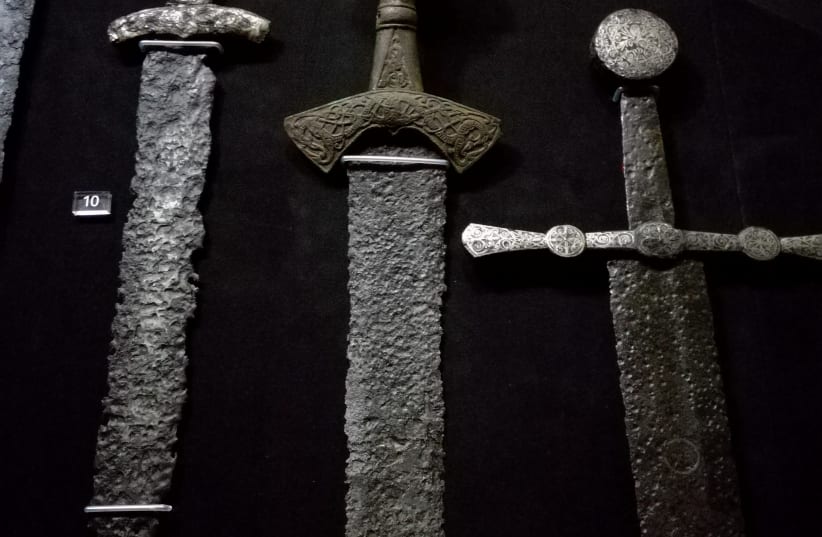The grave of an Iron Age warrior in medieval Finland that has puzzled archaeologists for over half a century may in fact be the final resting place of a well respected warrior who would have identified as non-binary, a new study has found.
The nearly 1,000-year-old grave was first found in 1968 in Suontaka Vesitorninmäki, and archaeologists noted the presence of jewelry and fragments of clothes.
This, the researchers said at the time, meant that the person in the grave was dressed in feminine clothing.
However, this corpse was accompanied by the presence of a hiltless sword inside the grave, with another sword, a famous bronze-hilted sword, being buried over the grave itself. These are more masculine symbols and led to questions regarding the nature of just who exactly is buried in the grave.
This is notable because while there have been graves in Scandinavia with women buried with swords, these graves usually lacked the more "feminine" items like jewelry.
There is near-universal consensus that the grave belonged to someone very important and widely respected. However, for years, experts have puzzled over the gravesite, with some saying it could have been the burial site of both a man and a woman. However, it has also long been touted as evidence of a warrior woman, with the National Museums of Finland and Denmark both touting the grave and the bronze-hilted sword as proof of a female warrior leader.
But as these researchers have found out, popular theories may have been way off the mark.
The DNA analysis conducted by researchers from the University of Turku, the findings of which were published in the peer-reviewed academic periodical European Journal of Archaeology, found that whoever was buried could have had XXY chromosomes, meaning a mix of male and female chromosomes, which some may have called or identified as non-binary.
This condition is known as Klinefelter syndrome, a very rare condition where someone who is biologically a male is born with one or more extra X chromosomes. It is prevalent in one to two per every 1,000 live male births and while rare, is the most common chromosomal disorder.
There is no indication if one will suffer from this condition and as such, there is no form of prevention. Those who have Klinefelter syndrome will still have male genitalia, but they will be small and poorly functioning, and will also be infertile. According to the UK National Health Service (NHS), Klinefelter syndrome can also cause other effects throughout one's life. They might learn to walk and talk later than life, be shy and have low-self confidence, low energy and problems with reading and writing, greater height, weaker muscles, breast growth, less body hair, and low sex drive.
The condition itself usually does not cause any harm to the body beyond infertility, though the NHS says it also comes with an increased risk of autoimmune disorders, hypothyroidism, anxiety and depression, osteoporosis, type 2 diabetes, blood clots, and, in very rare cases, male breast cancer.
However, could someone with Klinefelter syndrome have been a warrior? There is no reason why not, per se. However, the researchers also note some curious finds about the swords themselves. The famous bronze-hilted sword was buried likely at a later date and on top of the previous grave, something the researchers note could be done for mystical purposes. The hiltless sword in the grave itself, however, was buried purposefully. This typically signified personal identity and personhood. However, the sword itself has no sign of damage or use, and the lack of hilt might have made using it difficult unless the hilt was organic and as such degraded.
Considering the region at the time is indicated by other archaeological finds to have been a violent and turbulent place, it is especially strange that the sword has no sign of use. But a warrior with an unused sword is itself somewhat unusual.
So what role, exactly, would this person have fit in society? Would they identify as a man or woman? Would they conform to gender norms?
The answer is unclear, but as noted by the researchers, the concept of gender norms may not be what is commonly understood today.
Early medieval Scandinavia has often stereotypically been seen as a hypermasculine environment, and any man who held a feminine role in society or in feminine clothing would have been disrespected and shamed.
However, this is not exactly clear. There is some evidence that cross-dressers may have had a social niche for religious purposes, derived from the concept that in Norse mythology, Odin was associated with feminine magic.
And while Norse cultures in traditional Scandinavia may have viewed it as disrespectful, the people in Finland were not exactly Norse but were Finnic and Sámi. Perhaps, the researchers propose, cross-dressing shamans and sorcerers would have been more respected by Finnic and Sámi peoples.
It isn't without precedent either. One 12th-century grave excavated in Vivallen, Sweden, and believed by some to have been Sami, was biologically make and yet buried in feminine dress and with masculine items. This could be evidence of gender-mixing or non-binary societal roles and views.
But another possibility is that the person in the grave was never respected for their gender role or for being non-binary. Rather, there is another distinct possibility: The person in question already held a prominent position due to being part of a prominent family. It would explain the jewelry, swords, elaborate furnishings, and clothing. Being in such a prominent position may have allowed this person to express their gender identity and life choices however they liked.
Regardless, two things are certain: The person in the grave was certainly important, regardless of their gender or societal role, and our understanding of societies in medieval Scandinavia is not yet fully understood.
